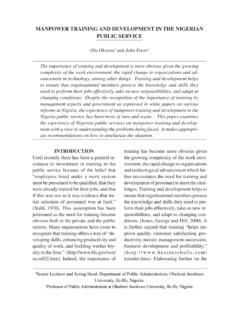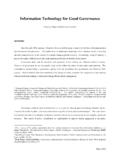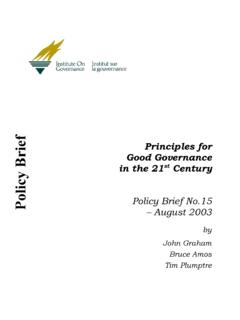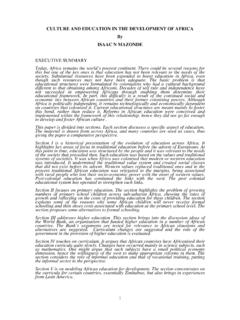Transcription of Classification and Compensation Strategies - …
1 Classification and Compensation Strategies By Prof. Chang-hyun Cho, Chairperson Republic of Korea Civil Service Commission As part of the effort to develop and maintain a quality workforce, public sector organizations must position themselves as employers of choice and recognize the value of their human capital. The methods by which employees are recruited, trained, retained, measured, and compensated are under scrutiny to ensure that goals can be accomplished and that future needs can be met. It is not enough to develop and implement programs to recruit, train, retain, measure and compensate -- in the face of global competition, organizations must develop Strategies to manage these important human resource functions. In today's market a number of organizations are continuously seeking new Strategies to meet both organizational and employee needs. From a global perspective there are still substantial differences in the way people get paid. However, organizations are finding that their human resource strategy can be structured using similar philosophies to reward people regardless of where there are located.
2 The logic of market-based economies suggests that the differences are narrowing as employers worldwide cope with similar pressures. All are affected by intense competition for critical skills; or are influenced by global financial markets. Public sector organizations need to develop aggressive pay policies to compete successfully for well-qualified employees. Compensation levels must be high enough to attract a strong applicant pool and retain the best among current employees. Morale is enhanced if employees know they are being paid at least as much as comparable employees are being paid by other employers. Classification and Compensation systems should therefore not only classify positions on the basis of uniform criteria, but also allocate positions to salary grades that reflect their relative worth and market value. An increasing number of organizations are trying to link pay to performance, through programs such as variable or incentive pay, where a percentage increase in pay depends on the employee's achievement of predetermined measurable goals; skill-based pay, where employees are paid for the number of skills they possess; and most recently, competency-based pay, in which an employee is paid for the range, depth and types of skills and knowledge he/she is capable of using in the job rather than for the position they hold.
3 This paper will address the trend toward developing long-term Classification and Compensation Strategies that are linked to organizational goals, as well as examine various pay systems and structures. Best practices in implementing pay Strategies will also be discussed. Long-term Strategies Compensation and reward systems can become an important signal of an organization's culture and values. When considered from a strategic perspective, organizations could customize Classification and Compensation systems to help create a culture and attract a workforce that possesses the values, knowledge, skills, and abilities that support the organization's strategic goals and objectives. The guiding principles for a successful Classification and Compensation program should ensure that: Employees doing similar work should receive comparable wages Variations in pay must be based on significant differences in responsibilities and required knowledge, skills, and abilities (KSAs) on salaries paid by other employers in the marketplace.
4 The process for classifying and evaluating the relative worth of positions must be fair. In addition, a Classification and Compensation plan that is continuously maintained results in: Fewer requests for reclassifications, Fewer grievances arising out of disputed job requirements, Fewer pay inequities and morale problems, and A solid basis for evaluating work performance. One of the most fundamental and difficult tasks in the management of any personnel system is determining the comparative worth of each position. Employees are acutely aware of what they are paid, how much responsibility they are assigned, and the status of their positions in relation to other positions. Perceived inequities in pay or status can be a source of intense dissatisfaction, which translates into declining morale, lost productivity, absenteeism, grievances, and chronic bickering. It is impossible to eliminate all feelings among employees that inequalities exist in the pay system, but every effort can be made to achieve fair job groupings and an equitable pay level for all positions in the workforce.
5 In recent years, organizations have responded to changes in the economy and shortages of employees with specific skills by taking a short-term approach that addresses the immediate need. Changes made to increase the flexibility of current Classification and pay systems have allowed organizations to be more responsive to the changes in the external climate and internal needs. The broadening of job classes, allowing for higher pay maximums, is just one way that flexibilities have been introduced. Those types of initiatives have been generally successful in the public sector, and will be discussed later in greater detail. It is clear that most public sector employers have at least considered making tactical changes to Classification or pay plans. Organizations that develop long-term pay Strategies recognize the important role that Compensation can play in achieving business objectives. Pay strategy looks at using pay to motivate employee behavior towards the achievement of employer goals, and bases salary levels and salary increases on the value employees bring to their work.
6 Cary Randow, Compensation Manager for the State of Washington in the United States, discusses in a recent IPMA-HR report, Compensation Strategies in the Public Sector, five important elements that make up the foundation for pay strategy: Pay Philosophy: The organization's concept of how employees will be compensated. It communicates the employer's direction and intent about employee's salaries. An organization's pay philosophy must be simply stated, practical in its approach and application, and clearly communicated. It is a vitally important component in preparing management to understand and apply employee salaries and salary changes in ways and circumstances that consistently support the employer's strategic goals. Pay philosophy is the core element in developing a successful pay strategy. Pay Competitiveness: Easy to understand but difficult to achieve and communicate. The main reason, for most public sector employers, is the general unpredictability of operating budgets, which often negatively impact the organization's ability to fund employee salary increases.
7 Most employers address pay competitiveness issues from only a tactical perspective, focusing on the individual situation as the issue presents itself. However, most public sector employers will never achieve total salary competitiveness if they continue with a short-term approach. Employers focused on pay strategy, however, have a much better chance to succeed by managing and defining it on their terms. Competitiveness from the perspective of a pay strategy suggests that the organization prioritize based on both the position and the person. Salary dollars are directed to those positions most critical to the employer's operating mission(s). while also addressing retention of critically skilled employees and those employees performing at high levels. This approach to pay competitiveness, while unlike the approach typically taken in the public sector, can be very effective in achieving business results. Paying competitively also does not necessarily mean paying the market average.
8 Pay strategy focuses on total Compensation (salaries and benefits). and ranges of pay as opposed to specific pay levels to attract and retain employees. Pay Delivery in the public sector has traditionally been through rigid and inflexible systems. Traditional pay structures with pre-determined pay steps and timing intervals are still common in many jurisdictions, and are the most frequently used structure for delivering base salary and salary increases to employees. High performing organizations are often those that recognize and reward achievement in as many ways and circumstances as possible. Allowing managers greater discretion in pay structure can be very beneficial in positioning the organization as an employer of choice. Public sector employers who are able to use Compensation to attract and retain high performers will experience the most success in the accomplishment of their business mission. Pay Practices are the systems an organization uses to deliver pay and pay increases.
9 Pay practices play an important role in the application of pay Strategies in the public sector; from the way a pay increase is granted ( base pay or lump sum) to increases for special skills, job hazards or geographic work location. Public jurisdictions can maximize long-term pay Strategies by adopting flexible and innovative pay structures and systems that integrate well with each other and accomplish their purpose. Communication is an important, but often worst applied component of personnel system change. Typically, information is shared with employees on a just in time . basis, and oftentimes knowledge is typically uneven throughout the management structure and messages and timing usually are out of synch. Developing a strategic approach to communicating your pay strategy helps assure that the right messages are delivered and received in the right time and in the right manner. A well developed communications plan will support an important strategic objective of achieving employee understanding of the organization's Compensation plan.
10 Tips for Successfully Developing and Implementing a Classification and Pay System Hold orientation meetings with government officials and employees to explain project activities and objectives. If they are not already available, draw organizational charts of the whole administration and of individual agencies. Determine job duties and responsibilities (essential functions) using trained observers, on-site interviews, position analysis questionnaires, or work logs. Develop draft and final job descriptions. Rate positions and assign them to pay grades on the basis of an objective evaluation system. Establish salary schedule(s) using comparative salary data. Provide guidelines for maintaining and updating the position Classification and Compensation plan. Review requests for reclassification, rate positions using a standard rating system, and adjust the Classification accordingly. If needed, update organizational charts to reflect changes in positions and ranks. Update salary schedules to reflect annual cost-of-living increases.











